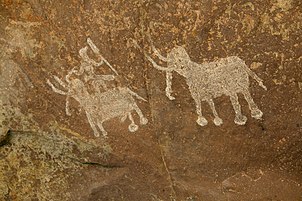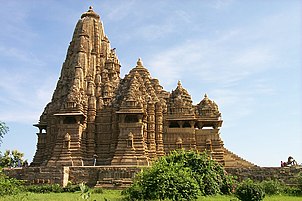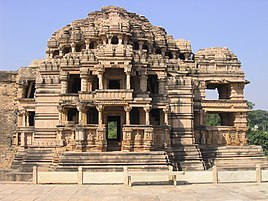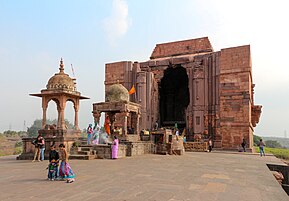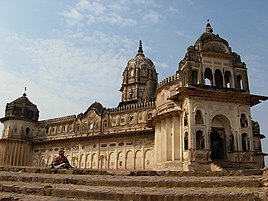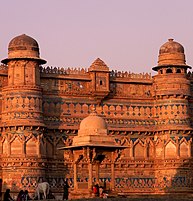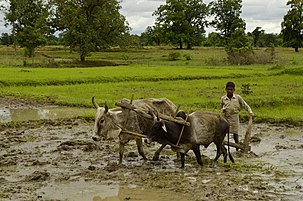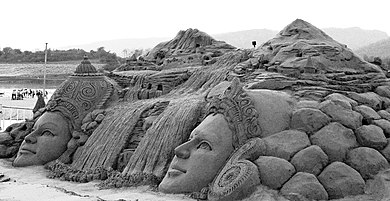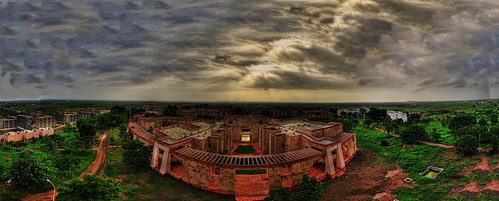Madhya Pradesh
Madhya Pradesh | ||
|---|---|---|
Kanha National Park | ||
|
Formation 26 January 1950 | | |
State Legislature | Unicameral | |
| • Assembly | Madhya Pradesh Legislative Assembly (230 seats) | |
| National Parliament | Parliament of India | |
| • Rajya Sabha | 11 seats | |
| • Lok Sabha | 29 seats | |
| High Court | Madhya Pradesh High Court | |
| Area | ||
| • Total | 308,252 km2 (119,017 sq mi) | |
| • Rank | Song Mera Madhya Pradesh (My Madhya Pradesh)[1] | |
| Bird | Indian paradise flycatcher | |
| Fish | Mahseer | |
| Flower | White lily | |
| Fruit | Mango | |
| Mammal | Barasingha | |
| Tree | Banyan Tree | |
| State highway mark | ||
 | ||
| State highway of Madhya Pradesh MP SH1 - MP SH53 | ||
| List of Indian state symbols | ||
Madhya Pradesh (/ˌmɑːdjə prəˈdɛʃ/,[8] Hindi: [ˈməd̪ʱjə pɾəˈdeːʃ] ⓘ; meaning 'central province') is a state in central India. Its capital is Bhopal, and the largest city is Indore, with Gwalior, Jabalpur, Ujjain, Dewas, Sagar, Satna, and Rewa being the other major cities. Madhya Pradesh is the second largest Indian state by area and the fifth largest state by population with over 72 million residents. It borders the states of Uttar Pradesh to the northeast, Chhattisgarh to the east, Maharashtra to the south, Gujarat to the west, and Rajasthan to the northwest.[9]
The area covered by the present-day Madhya Pradesh includes the area of the ancient
Etymology
Madhya Pradesh means "the central province" in Hindi.
History

Isolated remains of
The city of
The Satavahana King Gautamiputra Satakarni inflicted a crushing defeat upon the Saka rulers and conquered parts of Malwa and Gujarat in the 2nd century CE.[18]
Subsequently, the region was
The Medieval period saw the rise of the
The
The Mughal control weakened considerably after the death of
After the
During the
After the independence of India, Madhya Pradesh was created in 1950 from the former British
-
Mesolithic rock painting, Bhimbetka rock shelters, a UNESCO World Heritage Site
-
Khajuraho
-
Bateshwar temple complex, Padavli, Morena
-
Chausath Yogini Temple, Mitavli, Morena
-
Teli ka Mandir, Gwalior Fort
-
Shiva Temple in Bhojpur
-
Lakshmi Temple, Orchha
-
Brahma statue with various deities at Amarkantak.
-
Gwalior Fort, Gwalior
-
Gwalior Fort
-
Maa Chamunda Mata Temple, Tekri Dewas
-
Mahakaleshwar Temple Ujjain
-
Maheshwar Ghats and Fort, Maheshwar, Khargone
-
Omkareshwar Temple, Khandwa
Geography
Location in India
Madhya Pradesh literally means "Central Province", and is located in the geographic heart of India in between the latitude of 21.6°N–26.30°N and longitude of 74°9'E–82°48'E. The state straddles the Narmada River, which runs east and west between the Vindhya and Satpura ranges; these ranges and the Narmada are the traditional boundaries between the north and south of India. The highest point in Madhya Pradesh is Dhupgarh, with an elevation of 1,350 m (4,429 ft).[25]
The state is bordered on the west by Gujarat, on the northwest by Rajasthan, on the northeast by Uttar Pradesh, on the east by Chhattisgarh, and on the south by Maharashtra.

Climate
Madhya Pradesh also has three major seasons – Summer, Monsoon, and Winter. During summer (March–June), the temperature in the entire state ranges above 34.6 it has increased as it is all-time high in Madhya Pradesh. In general, the eastern parts of Madhya Pradesh are hotter than the western parts. The regions like Gwalior, Morena and Datia record temperatures of over 42 °C in May. The humidity is relatively very low and the region usually experiences frequent mild dust storms. The southwest Monsoon usually breaks out in mid-June and the entire state receives a major share of its rainfall between June and September. The south and south-east regions tend to experience a higher rainfall whereas the parts of the north-west receive less. Mandla, Balaghat, Sidhi, Jabalpur, and other extreme eastern parts receive more than 150 cm of rainfall. The districts of western Madhya Pradesh receive less than 80 cm of rainfall.[26]
The winter season starts in November. The temperature remains low in the northern parts of the state in comparison to the southern parts. The daily maximum temperature in most of the northern part of January remains between 15 and 18 °C. The climate is generally dry and pleasant with a clear sky. The average rainfall is about 1,194 mm (47.0 in). The southeastern districts have the heaviest rainfall, some places receiving as much as 2,150 mm (84.6 in), while the western and northwestern districts receive 1,000 mm (39.4 in) or less.
Ecology
According to the 2011 figures, the recorded forest area of the state is 94,689 km2 (36,560 sq mi) constituting 30.7% of the geographical area of the state.
The major types of soils found in the state are:
- Black soil, most predominantly in the Malwa region, Mahakoshal and in southern Bundelkhand
- Red and yellow soil, in the Baghelkhandregion
- Alluvial soil, in Northern Madhya Pradesh
- Laterite soil, in highland areas
- Mixed soil, in parts of the Chambaldivisions
Flora and fauna
Madhya Pradesh is home to ten
There are also a number of nature reserves, including
-
Langur monkey (Semnopithecus dussumieri), Orchha
-
Tigress with cubs in Kanha Tiger Reserve
-
Tickell's blue flycatcher, Bandhavgarh National Park
-
Vultures in the nest, Orchha
-
Male nilgais fighting, Lakeshwari, Gwalior district
Kanha, Bandhavgarh, Pench, Panna, and Satpura National Parks are managed as
Based on composition, the
State symbols of Madhya Pradesh
| Title | Symbol | Image |
|---|---|---|
| State animal | (Rucervus duvaucelii) | 
|
| State bird | Indian paradise flycatcher (Terpsiphone paradisi)[33] | 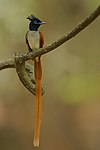
|
| State tree | banyan tree (ficus bengalensis)[34]
|

|
| State fish | Mahasheer (Tor tor)[33] | 
|
| State Flower | Madonna lily (Lilium candidum)[35] | 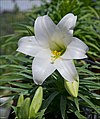
|
Rivers
-
Narmada River
-
Son River, Umaria district, MP, India
-
The River Narmada flows through a gorge of marble rocks in Bhedaghat, Jabalpur
-
The Shri Ram Ghat on the Shipra River in Ujjain
-
Betwa in the Ashoknagar District of Madhya Pradesh
The
The
After the formation of Chhattisgarh State, the major portion of Mahanadi basin now lies in Chhattisgarh. Presently, only 154 km2 basin area of Hasdeo River in Anuppur District lies in Madhya Pradesh.
The
Regions
Madhya Pradesh is divided into the following agro-climatic zones:
Administration
Madhya Pradesh is divided into 55 districts for administrative purposes. The district is the main unit of administration. These districts are arranged in 10 divisions, listed below:[36]
- Bhopal Division
- Chambal Division
- Gwalior Division
- Indore Division
- Jabalpur Division
- Narmadapuram Division
- Rewa Division
- Sagar Division
- Shahdol Division
- Ujjain Division
Cities
Rank
|
Name
|
District | Pop.
|
||||||
|---|---|---|---|---|---|---|---|---|---|
 Indore  Bhopal |
1 | Indore | Indore | 2,167,447 |  Jabalpur  Gwalior | ||||
| 2 | Bhopal | Bhopal | 1,883,381 | ||||||
| 3 | Jabalpur | Jabalpur | 1,267,564 | ||||||
| 4 | Gwalior | Gwalior | 1,101,981 | ||||||
| 5 | Ujjain | Ujjain | 593,368 | ||||||
| 6 | Sagar | Sagar | 370,296 | ||||||
| 7 | Dewas | Dewas | 289,438 | ||||||
| 8 | Satna | Satna | 283,004 | ||||||
| 9 | Ratlam | Ratlam | 273,892 | ||||||
| 10 | Rewa | Rewa | 235,422 | ||||||
Demographics
Population
| Year | Pop. | ±% |
|---|---|---|
| 1951 | 18,615,000 | — |
| 1961 | 23,218,000 | +24.7% |
| 1971 | 30,017,000 | +29.3% |
| 1981 | 38,169,000 | +27.2% |
| 1991 | 48,566,000 | +27.2% |
| 2001 | 60,348,000 | +24.3% |
| 2011 | 72,597,565 | +20.3% |
| Source: Census of India[38] | ||
The population of Madhya Pradesh consists of a number of
The main tribal groups in Madhya Pradesh are
Madhya Pradesh ranks(33rd) on the
-
Children in Raisen district, Bhil tribe
-
Shepherds in Chambal
-
A young farmer in Umaria district
-
YoungBaigawomen
Languages
The official language of the state is Hindi, which is spoken by over two-thirds of the population and is used for all government business.[4] In urban areas Standard Hindi is the main language, while Urdu is spoken by Muslims. In rural areas, however, most speak varieties counted as dialects of Hindi in the census, although most are quite distinct. In the west are Malvi and Nimadi in the Malwa and Nimar regions, which are more closely related to the Rajasthani languages. In Bundelkhand in the north and Baghelkhand in the east are spoken Bundeli and Bagheli which are eastern varieties of the Hindi languages, similar to Awadhi or Chhattisgarhi. In the southeast is spoken Chhattisgarhi and Powari is the language of the far south, both Eastern Hindi languages. Most speakers of these languages consider them to be dialects of Hindi and so report their language as 'Hindi' on the census.[43]
Marathi is another significant language. Due to Maratha rule over much of what is now Madhya Pradesh, Madhya Pradesh is home to the largest number of Marathis outside Maharashtra. Although large numbers of Marathis can be found in urban centres like Indore, the highest concentrations are in the southern areas of the state adjoining Maharashtra. Marathi is the most-spoken language in Burhanpur district, while it is a major minority language in the southern parts of Mahakoshal especially Betul, Chhindwara and Balaghat districts.[43]
There are several languages spoken by the Adivasis. The various Bhil languages are Indo-Aryan languages spoken by 50 lakh Bhils of western Madhya Pradesh. Although many, especially in the eastern parts of their range, have adopted the regional languages as mother tongue, the languages are still strong in the far-western hills especially Barwani, Jhabua and Alirajpur districts where they are in the majority. Bhili, the Bareli languages and Bhilali are the major varieties spoken in the state.
Korku, a Munda language, has over 400,000 speakers in the central highlands of the state. In the far-southeast of Burhanpur can be found some speakers of the language isolate Nihali who live among the Korku. All speakers of tribal languages face significant pressure to switch to the dominant regional languages while their own tongues are considered 'backward' and 'rural'.[43]
The following languages are taught in schools in Madhya Pradesh under the Three Language Formula:[44]
First language: Any
Second language: Hindi, Urdu or English
Third language: Another Scheduled Language, Arabic, Persian, French, Russian
Religion
Hinduism is the main religion and is followed by 90.9% of the population.
According to the census of 2011, 90.9% of residents followed
Culture
-
Bagh Print Traditional hand block print craft in Bagh.
-
A man playing flute intilakon his forehead, and holy saffron-coloured clothes.
-
Sand sculpture bySudarshan Pattnaikat Bandrabhan near Narmadapuram
Three sites in Madhya Pradesh have been declared
Madhya Pradesh is noted for its classical and folk music. Some of the noted
The major folk dances of MP are
Economy

Madhya Pradesh's
Madhya Pradesh is also famous for honey production in district Morena.
The state has an
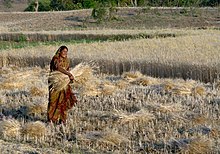
Madhya Pradesh has 5
The Industrial Belts of Indore-Dewas-Pithampur and Mandideep (Bhopal) are the prominent Industrial Hubs of Madhya Pradesh. Numerous industrial units and factories are present there such as Mechanical and Industrial Parts (gears, cables), Chemical Production Units, Pharmaceutical Units, Food Processing & FMCG Industries, Textile Production, Food Grain Processing Units, Leather Industry and Sanitary Products etc.
The state has the largest reserves of diamond and copper in India. Other major mineral reserves include those of coal, coalbed methane, manganese and dolomite.[52]
Madhya Pradesh has six
There are two major Security Press Units of
The second unit is a Security Paper Mill was established in 1968 at Hoshangabad. It produces papers for banknotes and non–judicial stamps and further prints with new enhanced unit.
Madhya Pradesh won the 10th National Award for excellent work in Mahatma Gandhi National Rural Employment Guarantee Act, 2005.
The state's tourism industry is growing, fuelled by wildlife tourism and a number of places of historical and religious significance.
Infrastructure
Energy
| Power | Capacity (MW) |
|---|---|
| Thermal | 16,387.09
|
| Renewable | 7,098.37
|
| Hydro | 3,223.66
|
| Nuclear | 273.0
|
The state has a total installed power generation capacity of 27108.55 MW as of 31 March 2024. The Madhya Pradesh Electric Board is located at Jabalpur. The Rewa Ultra Mega Solar project is a photovoltaic solar park spread over an area of 1,590 acres (6.4 km2) in the Gurh tehsil of Rewa District of Madhya Pradesh.[54] The project was commissioned with 750 MW capacity.[55] 97% households have electricity access in the state.[56]
The Singrauli region on the eastern end of Madhya Pradesh is a major energy producer enclave for the country. The region has vast reserves of coal mines, which are excavated by Northern Coalfields Limited, a subsidiary of Coal India Limited, which is in turn used in local power plants of NTPC, Sasan Power and Hindalco. The area has more than 10,000 MW installed capacity for energy production.
The region of Malwa were selected to establish Wind Energy Production units by State Government. Constant wind flows in the region are suitable for harvesting wind energy. There are more than 100 wind mills on a series of hills 13 km (8.1 mi) from Dewas, generating more than 30 megawatts of power. These were financed by a few private companies which sought a reliable power supply.
Transport
| Road type | Length (in km) |
|---|---|
| National Highways | 8,772
|
| State Highways | 11,000
|
| Major District Roads | 19,241
|
Bus and train services cover most of Madhya Pradesh. The 99,043-kilometre-long (61,542 mi) road network of the state includes 20
The major
The state does not have a coastline. Most of the sea trade happens through the Kandla and Jawaharlal Nehru Port (Nhava Sheva) in the neighbouring states, which are well-connected to MP by road and rail networks.
Other
The state has 55 districts hospitals, 333 community health centres, 1,155 primary health centres and 8,860 sub-centres.[58][59]
The urban infrastructure has improved considerably in the past decade. 22 projects costing above $500 million have been sanctioned under the Jawaharlal Nehru National Urban Renewal Mission for the development of Bhopal, Indore, Jabalpur and Ujjain.[52]
Seven Cities of Madhya Pradesh Bhopal, Indore, Gwalior, Jabalpur, Satna, Ujjain, and Sagar have been selected under Smart cities mission[60][61]
Indore has been part of the Swachh Survekshan Cleanliness Program initiated by Government of India. It has been ranked as India's cleanest city six years in a row as per the Swachh Survekshan for the years 2017, 2018, 2019, 2020, 2021 and 2022.
Media
Dainik Bhaskar, Dainik Jagran, The Indian Observer, Nava Bharat, Deshbandhu, Nai Duniya, Rajasthan Patrika, Raj Express and Dainik Dabang Dunia are the leading Hindi newspapers. Other local newspapers are published in the cities. In English Times of India, Hindustan Times, The Hitavada, Central Chronicle and Free Press have editions from Bhopal with The Hitavada also being in Jabalpur. A Sindhi daily, i.e., Challenge (Now also in Hindi) is published from Bhopal is the only Sindhi newspaper in state.
Government and politics
Madhya Pradesh has a 230-seat state legislative assembly. The state also sends 40 members to the
The dominant political parties in the state are the Bharatiya Janata Party (BJP) and the Indian National Congress (INC).
Administration
Madhya Pradesh state is made up of 55
| S/N | Corporation Name | City | District(s) | Area (km2) | Population (2011) | No. of Wards | Year Established | Last Election | Ruling Party | Website |
|---|---|---|---|---|---|---|---|---|---|---|
| 1 | Bhopal Municipal Corporation | Bhopal | Bhopal | 463 | 1,886,100 | 85 | 2022[63] | BJP | [64] | |
| 2 | Burhanpur Municipal Corporation
|
Burhanpur | Burhanpur | 181.06 | 300,892 | 2022[63] | BJP | |||
| 3 | Chhindwara Municipal Corporation | Chhindwara | Chhindwara
|
110 | 234,784 | 48 | 2022[63] | INC | [65] | |
| 4 | Dewas Municipal Corporation | Dewas | Dewas | 50 | 289,438 | 2022[66] | BJP | [67] | ||
| 5 | Gwalior Municipal Corporation | Gwalior | Gwalior | 289 | 1,117,740 | 66 | 2022[63] | INC | ||
| 6 | Indore Municipal Corporation | Indore | Indore | 530 | 2,167,447 | 85 | 2022[63] | BJP | [68] | |
| 7 | Jabalpur Municipal Corporation | Jabalpur | Jabalpur | 263 | 1,268,848 | 2022[63] | INC | |||
| 8 | Katni Municipal Corporation | Katni | Katni | 221,875 | 2022[66] | Independent | [69] | |||
| 9 | Khandwa Municipal Corporation | Khandwa | Khandwa | 259,436 | 2022[63] | BJP | [70] | |||
| 10 | Morena Municipal Corporation | Morena | Morena
|
80 | 218,768 | 2022[66] | INC | |||
| 11 | Ratlam Municipal Corporation | Ratlam | Ratlam | 39 | 273,892 | 49 | 2022[66] | BJP | [71] | |
| 12 | Rewa Municipal Corporation | Rewa | Rewa | 69 | 235,422 | 45 | 2022[66] | INC | [72] | |
| 13 | Sagar Municipal Corporation | Sagar | Sagar
|
49.76 | 370,296 | 2022[63] | BJP | |||
| 14 | Satna Municipal Corporation | Satna | Satna | 71 | 283,004 | 2022[63] | BJP | |||
| 15 | Singrauli Municipal Corporation | Singrauli | Singrauli
|
225,676 | 2022[63] | AAP | ||||
| 16 | Ujjain Municipal Corporation | Ujjain | Ujjain | 151.83 | 515,215 | 54 | 2022[63] | BJP | [73] |
Villages
Education
-
Rajiv Gandhi Technical University's main gate
-
IIM Indore's aerial panoramic view
-
St. Aloysius Senior Secondary School, Jabalpur, established in the year 1868 is among the oldest schools in India
According to the 2011 census, Madhya Pradesh had a literacy rate of 69.32%. According to the 2009–10 figures, the state had 105,592 primary schools, 6,352 high schools, and 5,161 higher secondary schools. The state has 208 engineering and architecture colleges, 208 management institutes, and 12 medical colleges.[52]
The state is home to some of the premier educational and research institutions of India including
There are 500 degree colleges, which are affiliated with one of the universities in the state. The specialised universities include
The Professional Examination Board was initialised as Pre Medical Test Board by Government of Madhya Pradesh in the year 1970. After some year in 1981, Pre Engineering Board was constituted. Then after, in the year 1982 both these boards were amalgamated and named as
Tourism
Notable people
Sports
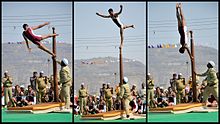
In 2013, state govt declared Mallakhamba as the state sport.[74]
are popular in the rural areas.Snooker, a cue sport, generally regarded as having been invented in Jabalpur by British Army officers, is popular in many of the English-speaking and Commonwealth countries, with top professional players attaining multimillion-pound career earnings from the game.

Cricket is the most popular sport in Madhya Pradesh.[
Aishbagh Stadium in Bhopal is the home ground for World Series Hockey team Bhopal Badshahs. The state also has a football team that participates in the Santosh Trophy.
On 6 December 2017, the Madhya Pradesh
Madhu Yadav, the former Captain of the India women's national field hockey team, a 1982 Asian Games gold medallist and an Arjuna Award recipient, is from Jabalpur.[76]
See also
- Outline of Madhya Pradesh
- Directorate Sports and Youth Welfare
- Districts of Madhya Pradesh
- List of forts in Madhya Pradesh
- List of people from Madhya Pradesh
References
- ^ "MP: State Song to be Sung Along with National Anthem". Outlook. 12 October 2010. Archived from the original on 21 March 2020. Retrieved 21 March 2020.
- ISBN 978-81-7387-135-1.
- ^ "2011 Census of India" (PDF). Censusindia.gov.in. Archived from the original (PDF) on 17 October 2011. Retrieved 14 September 2012.
- ^ a b "Report of the Commissioner for linguistic minorities: 47th report (July 2008 to June 2010)" (PDF). Commissioner for Linguistic Minorities, Ministry of Minority Affairs, Government of India. pp. 122–126. Archived from the original (PDF) on 13 May 2012. Retrieved 16 February 2012.
- ^ a b "MOSPI State Domestic Product, Ministry of Statistics and Programme Implementation, Government of India". 15 March 2021. Archived from the original on 15 April 2021. Retrieved 28 March 2021.
- ^ "Sub-national HDI – Area Database". Global Data Lab. Institute for Management Research, Radboud University. Archived from the original on 23 September 2018. Retrieved 25 September 2018.
- ^ "Sex ratio of State and Union Territories of India as per National Health survey (2019-2021)". Ministry of Health and Family Welfare, India. Archived from the original on 8 January 2023. Retrieved 8 January 2023.
- ^ "Madhya Pradesh". Merriam-Webster.com Dictionary.
- ^ "Archived copy" (PDF). Archived (PDF) from the original on 5 February 2020. Retrieved 30 October 2019.
{{cite web}}: CS1 maint: archived copy as title (link) - ^ "Human Development Index Across Indian States: Is the Glass Still Half Empty?" (PDF). Archived (PDF) from the original on 9 June 2021. Retrieved 9 June 2021.
- ^ "India State of Forest Report 2019" (PDF). Archived (PDF) from the original on 17 March 2022. Retrieved 17 July 2022.
- ^ "Madhya Pradesh topped the National Tourism Awards 2010–11". jagranjosh.com. 1 January 2012. Archived from the original on 19 June 2012. Retrieved 14 September 2012.
- ^ "Madhya Pradesh topples Bihar, new No 1 in economic growth". Economic Times. 30 March 2013. Archived from the original on 2 April 2013. Retrieved 30 March 2013.
- ^ "Madhya Pradesh Presentation and Economy Growth Report | IBEF". ibef.org. Archived from the original on 28 February 2017. Retrieved 26 February 2021.
- ^ "The Hathnora Skull Fossil from Madhya Pradesh, India" (PDF). Geological Survey of India. 20 September 2005. Archived from the original (PDF) on 16 September 2012. Retrieved 8 September 2012.
- ISBN 978-0-472-11013-1. Archivedfrom the original on 7 June 2013. Retrieved 8 September 2012.
- ISBN 978-81-8069-521-6. Archivedfrom the original on 6 June 2013. Retrieved 8 September 2012.
- ^ Ancient India by Ramesh Chandra Majumdar: p. 134.
- ISBN 978-1-4073-0151-8, p. 19.
- ^ A Journey through India's Past (Great Hindu Kings after Harshavardhana), by Chandra Mauli Mani: p. 13.
- ^ A Brief History of India by Alain Daniélou p. 185.
- ^ History of India by N. Jayapalan pp. 149–151.
- ^ Dwarka Prasad Misha, ed. (1956). The History of freedom movement in Madhya Pradesh. Govt. Print., Madhya Pradesh.
- ^ Sen, Abha. "जबलपुर के हाथ से बस इसलिए निकल गई राजधानी की प्रबल दावेदारी". Patrika.com. Archived from the original on 15 November 2017. Retrieved 25 July 2017.
- OCLC 8112689.
- ^ "Government of Madhya Pradesh (M.P.)". Archived from the original on 9 June 2021. Retrieved 9 June 2021.
- ^ State of Forest Report (PDF). Forest Survey of India (Ministry of Environment & Forests). 2011. Archived from the original (PDF) on 12 May 2013. Retrieved 10 September 2012.
- ^ "India planted 66 million trees in 12 hours". The Independent. 3 July 2017. Archived from the original on 7 February 2019. Retrieved 5 February 2019.
- ^ Wild Life Archived 13 November 2012 at the Wayback Machine. Forest Department, Madhya Pradesh.
- ^ "MP Govt. to set up National Dinosaur Fossil Park in Dhar district". Ummid.com. Archived from the original on 14 February 2018. Retrieved 5 February 2018.
- ^ "Symbols of Madya Pradesh". knowindia.gov.in. Archived from the original on 12 November 2013. Retrieved 18 October 2013.
- ^ "Symbols of Madya Pradesh". Archived from the original on 19 October 2013. Retrieved 18 October 2013.
- ^ a b "State Symbols of MP". Madhya Pradesh State Biodiversity Board. Archived from the original on 25 July 2016. Retrieved 25 June 2016.
- ^ "Madhya Pradesh" (PDF). ENVIS Centre on Floral Diversity. Archived from the original (PDF) on 24 February 2016. Retrieved 16 February 2016.
- ^ "State Animals, Birds, Trees and Flowers of India". ENVIS Centre on Forestry. Archived from the original on 8 March 2016. Retrieved 10 January 2017.
- ^ "MPOnline: Contact Government". Mponline.gov.in. Archived from the original on 2 August 2018. Retrieved 26 August 2018.
- ^ "Urban Agglomerations/Cities having population 1 lakh and above" (PDF). Provisional Population Totals, Census of India 2011. Archived (PDF) from the original on 13 November 2011. Retrieved 13 February 2016.
- ^ "Census Population" (PDF). Census of India. Ministry of Finance India. Archived from the original (PDF) on 19 December 2008. Retrieved 18 December 2008.
- ^ [1][permanent dead link].
- ^ Madhya Pradesh: Economic and Human Development Indicators Archived 16 September 2012 at the Wayback Machine, UNDP (2011).
- ^ "GDP per capita of Indian states - StatisticsTimes.com". Archived from the original on 3 June 2021. Retrieved 9 June 2021.
- ^ "SDG INDIA - Index & Dashboard 2020-21 - Partnerships in the Decade of Action" (PDF). NITI Aayog. Archived from the original (PDF) on 12 June 2021. Retrieved 9 June 2021.
- ^ a b c d "Language – India, States and Union Territories" (PDF). Census of India 2011. Office of the Registrar General. pp. 13–14. Archived (PDF) from the original on 14 November 2018. Retrieved 15 December 2018.
- ^ "51st Report of the Commissioner for Linguistic Minorities in India" (PDF). nclm.nic.in. Ministry of Minority Affairs. 15 July 2015. p. 64. Archived from the original (PDF) on 16 February 2018. Retrieved 15 February 2018.
- ^ a b "Percentage of Hindus, Sikhs in MP declines, of Muslims rises". Hindustan Times. 1 January 2016. Archived from the original on 29 January 2020. Retrieved 22 February 2020.
- ISBN 978-1-85828-636-5. Archivedfrom the original on 6 June 2013. Retrieved 13 September 2012.
- ^ "Folk Songs – govt-of-mp-india". Government of Madhya Pradesh. Archived from the original on 14 August 2017. Retrieved 14 August 2017.
- ^ "Folk Dances – govt-of-mp-india". Government of Madhya Pradesh. Archived from the original on 14 August 2017. Retrieved 14 August 2017.
- ^ "Per Capita Net State Domestic Product at Current Prices" (PDF). Archived from the original (PDF) on 25 December 2014. Retrieved 25 December 2014.
- ^ "A special report on India: Ruled by Lakshmi 11 Dec 2008 from The Economist print edition". The Economist. Archived from the original on 10 March 2010. Retrieved 4 January 2009.
- ^ a b Lemuel Lall (29 June 2012). "Madhya Pradesh's GDP goes up to 12 per cent". The Times of India. Archived from the original on 2 May 2013. Retrieved 10 September 2012.
- ^ a b c d e f g h "Madhya Pradesh : The Land of Diamonds" (PDF). Ibef.org. November 2011. Archived from the original (PDF) on 27 September 2018. Retrieved 26 August 2018.
- ^ "All India Installed Capacity (in MW) Of Power Stations (as on 31.03.2024))" (PDF). cea.nic.in. Central Electricity Authority, Government of India. Retrieved 25 April 2024.
- ^ "Electricity | District Rewa, Government of Madhya Pradesh | India". Archived from the original on 10 July 2020. Retrieved 10 July 2020.
- ^ "750 MW Rewa solar project starts supplying power". pv magazine India. Archived from the original on 12 July 2020. Retrieved 12 July 2020.
- ^ "About Us | Energy Department, Government of Madhya Pradesh". Archived from the original on 9 June 2021. Retrieved 9 June 2021.
- ^ "Infrastructure". Archived from the original on 9 June 2021. Retrieved 9 June 2021.
- ^ "Madhya Pradesh: The Land of Diamonds" (PDF). India Brand Equity Foundation. March 2014. Archived from the original (PDF) on 10 August 2014. Retrieved 15 August 2014.
- ^ Sharma, Rajendra (5 July 2018). "MP govt clears proposal for 52nd district". The Times of India. Archived from the original on 17 September 2018. Retrieved 3 November 2019.
- from the original on 30 December 2017. Retrieved 4 September 2018.
- ^ "Full list of 98 smart cities – Times of India ►". The Times of India. Archived from the original on 19 November 2021. Retrieved 4 September 2018.
- ^ "Madhya Pradesh State Biodiversity Board". Mpsbb.info. Archived from the original on 17 March 2013. Retrieved 15 September 2012.
- ^ a b c d e f g h i j k "Phase 1 Madhya Pradesh Municipal Election Result 2022". Hindustan Times. 17 July 2022. Archived from the original on 26 April 2023. Retrieved 18 July 2022.
- ^ "Bhopal Municipal Corporation". Bhopal Municipal Corporation. Archived from the original on 2 December 2016. Retrieved 18 July 2022.
- ^ "Chhindwara Municipal Corporation". Archived from the original on 29 November 2023. Retrieved 19 June 2022.
- ^ a b c d e "Phase 2 Madhya Pradesh Municipal Election Result 2022". Free Press Journal. Archived from the original on 3 May 2023. Retrieved 20 July 2022.
- ^ "Dewas Municipal Corporation". Dewas Municipal Corporation. Archived from the original on 17 February 2024. Retrieved 18 July 2022.
- ^ "Indore Municipal Corporation". Archived from the original on 6 February 2022. Retrieved 18 July 2022.
- ^ "Katni Municipal Corporation". www.kmckatni.org. Archived from the original on 1 February 2022. Retrieved 18 July 2022.
- ^ "Khandwa Municipal Corporation". Municipal Corporation Khandwa. Archived from the original on 17 February 2024. Retrieved 19 June 2022.
- ^ "Ratlam Municipal Corporation". rmcratlam.in. Archived from the original on 1 May 2023. Retrieved 18 July 2022.
- ^ "Rewa Municipal Corporation". Archived from the original on 18 January 2023. Retrieved 18 July 2022.
- ^ "Ujjain Municipal Corporation". nagarnigamujjain.org. Archived from the original on 25 November 2015. Retrieved 18 July 2022.
- ^ Singhi, Ramendra. "State sport status to malkhamb". The Times of India. Archived from the original on 21 May 2017. Retrieved 24 December 2016.
- ^ Purohit, Abhishek (27 June 2022). "Madhya Pradesh end long wait to win Ranji Trophy; beat Mumbai by 6 wickets". The Indian Express. Archived from the original on 27 June 2022. Retrieved 28 June 2022.
- ^ "Madhya Pradesh: Former Indian women's hockey team captain celebrates India's victory against Australia". Free Press Journal. Archived from the original on 7 August 2021. Retrieved 7 August 2021.
Further reading
- Gyanendra Singh. Farm Mechanization in Madhya Pradesh. Bhopal: Central Institute of Agricultural Engineering, 2000.
- Madhya Pradesh (India). The Madhya Pradesh Human Development Report 2002: Using the Power of Democracy for Development. [Bhopal: Govt. of Madhya Pradesh, 2002].
- Nehru Memorial Museum and Library, New Delhi.
- Rag, Pankaj. Vintage, Madhya Pradesh: A Collection of Old Photographs. Bhopal: Madhya Pradesh Madhyam jointly with the Directorate of Archaeology, Archives, and Museums, 2005. ISBN 81-902702-7-3
- Parmar, Shyam. Folk Tales of Madhya Pradesh. Folk tales of India series, 12". New Delhi: Sterling Publishers, 1973.
- Rag, Pankaj, and O. P. Misra. Masterpieces of Madhya Pradesh. Bhopal: Directorate of Archaeology, Archives & Museums, Government of Madhya Pradesh, 2005.
- Sampath, M. D., H. V. Trivedi, and Mandan Trivedi. Epigraphs of Madhya Pradesh. New Delhi: Archaeological Survey of India, 2001.
- Sati, Vishwambhar Prasad. Madhya Pradesh, a Geo-Economic Appraisal. Delhi: Abhijeet, 2004. ISBN 81-88683-43-4
- Shah, Shampa, and Aashi Manohar. Tribal Arts and Crafts of Madhya Pradesh. Living traditions of India. Ahmedabad: Mapin Pub./in Association with Vanya Prakashan, Bhopal, 1996. ISBN 0-944142-71-0
External links
- Government
- General information
- Madhya Pradesh web resources provided by GovPubs at the University of Colorado Boulder Libraries
- Madhya Pradesh at the Encyclopædia Britannica
- Madhya Pradesh at Curlie
 Wikimedia Atlas of Madhya Pradesh
Wikimedia Atlas of Madhya Pradesh Geographic data related to Madhya Pradesh at OpenStreetMap
Geographic data related to Madhya Pradesh at OpenStreetMap

